At important celebrations, weddings, anniversaries, and receptions where a large number of guests are present, a specially designed seating chart for guests at the table is usually used. When drawing up such a seating arrangement, the rank of the invited guests must be taken into account.
Advice! In order not to rush around the table in search of your seat, it is recommended to first familiarize yourself with the seating chart. Typically, such a diagram is posted for public access, in the hall on a table, or sent out along with an invitation to a holiday or reception.
At receptions where a large number of guests are expected to be present, couvert cards are used, indicating the name and surname of the invited guest. Place them on a plate, near a glass of water or on a special stand.
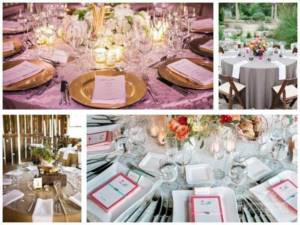
General seating rules
- So, just as the places at the common table are divided according to their importance into more and less honorable ones, guests, when seated at the table, occupy strictly defined places.
- The most honorable place is the one located to the right of the owner/hostess, the next in importance is to the left. The farther the place is from the owner/hostess, the less honorable it is.
- When seating at the table, alternating men and women is mandatory.
- Guests at the table should be seated, taking into account their common interests.
- The main guest at the table is always placed to the right of the owner or opposite him, facing the window or door.
- A foreign guest is always a priority over a compatriot guest.
- All guests are seated according to their position in society and rank at work. Wives take seats according to their husband's position.
- Husband and wife should not be seated next to or opposite each other. The exception is newlyweds.
- Only men sit at the end of the table; women have no place at the edge of the table.
On a note!
When seating guests, you should take into account their temperament, alternating between sociable and silent ones.
Seating traditions
Are you planning to follow all the traditions? Then the bride should be seated to the right of the groom, the witnesses - next to the couple, to the right of the bride - her mother and father of the groom, to the left of the groom - his mother and father of the bride. Next, the groom's relatives sit on the right, and the bride's relatives sit on the left. Grandparents and most honored guests should sit closer to the newlyweds, that is, immediately after the parents.
And lastly: when creating a seating chart, take into account the characters of the guests and their attitude towards each other. If European seating is expected, try to seat at least one sociable, funny person at each table who will not let other guests get bored. And if among the guests there are people who do not like each other, they should be seated at different ends of the hall.
Peculiarities of seating at an informal reception
- When arranging seating for an informal reception, the main guest is determined by the owner of the house. The most commonly used method is relative priority, but seating arrangements can also be made in accordance with the status of the invited people.
- When seating, the age of the guests must also be taken into account, grouping older guests separately from younger ones.
- The guest of honor is brought to the table by the owner of the house, the guest of honor is brought to the table by the hostess.
- At the table at an informal reception, the host and hostess sit opposite each other.
- Also, men and women who came together sit opposite each other.
- If guests come with children, then the children are seated at a separate table.
- When seating guests, the presence of mutual sympathy between the guests is taken into account.
On a note!
When creating a seating arrangement, it is important not to overload the table, seating instead of 8 – 10, or even 12 people at the same time. In order for those sitting to be comfortable and not to be crowded elbow to elbow, there should be about 60 cm per seat.
Round table scheme

A round table can be either round, in the literal sense of the word, or square or rectangular. The main condition is that all participants must see each other and communicate freely. This seating arrangement is suitable for formal events, such as negotiations and official receptions, and as banquet tables as part of a special event.
Loft #3 – 10 new halls, accommodating from 20 to 800 guests Digital navigation for business events DEEP Platform – platform No. 1 for online events Warm country tent 900 m² on the river bank Event.ru recommends – reliable contractors! Event.ru recommends the best venues! MF Group Technical support and event organization Dmitry Romanov is a star stand up comedian at your event! Everything for online/hybrid events Integrated technical production from Structura “ETM” - only we will create your unforgettable event 3 snow-white tents on the shore 1 km from the Moscow Ring Road!
How to get here?
All ads/Hide ads
Seating methods
The choice of seating method depends on the number of invited guests. Popular seating arrangements include:
- traditional. All guests sit at one table.
- American This method involves seating 8 people at separate tables.
- English Guests are seated at two parallel tables. Perfect for parties with children.
- Italian. Assumes seating for 4 people.
On a note!
When using American, English or Italian seating, tables are numbered and the invitation for guests indicates the number of the table intended for them.
Round table: seating details
Seating guests around a round table helps create a friendly atmosphere, and therefore implies close relationships between people. The advantage of this seating arrangement is the ability to see each other and, accordingly, maintain a general conversation at the table. The general seating rules are also taken into account here: alternation of men and women and priority of guests.
Knowing the rules of etiquette will allow you not only to organize a party correctly, but also not to get lost when invited to a reception. Using generally accepted rules for seating guests at the table will be the key to creating a pleasant atmosphere and good mood.
Publication date: 10/03/2017 11:28
Seating guests at a wedding is not an easy task. Many newlyweds don’t even think about its importance. After all, this is not just a list of names with a table number. This is the main secret of a fun holiday. None of the guests will rejoice at the fact that they will have to feast at the same table with an unpleasant person. Therefore, you should make a plan in advance where and with whom the invited guests will sit, so that everyone feels comfortable at the holiday. We are in a hurry to help you!
Why is a seating plan necessary?
1. Any guest does not have to worry about his place if he stays a little longer and arrives after the start of the celebration. His place will not be taken, and in the middle of the banquet you will not have to run around the hall looking for an empty chair.
2. With proper seating, best friends or families will definitely sit at the same table. This means they will feel comfortable.
3. Seating the guests will help avoid uncomfortable situations. It is unlikely that any of the guests will want to sit at the table with strangers. And young people are not eager to sit in the company of older couples.
4. For restaurant waiters, guest lists with table numbers are very important. Among the guests there may be, for example, allergy sufferers. Thanks to the detailed list, waiters will not confuse plates with dishes, and everyone will receive a treat that is prepared especially for them, taking into account their tastes and needs.
5. Knowing who is sitting at which table, guests will be able to quickly take their assigned seats in the hall. This means that seating arrangements will help avoid unnecessary fuss in the banquet hall.
Who is involved in drawing up the plan?
Planning seating at a banquet is the direct responsibility of both the bride and groom. This responsibility cannot be shifted to the wedding organizer. After all, only newlyweds know the interests, needs and characters of their guests. The newlyweds can plan their seating separately, that is, only on their part. But it would be better to start planning together. If distant relatives are invited to the celebration, then parents can also be involved in the process. When planning, you can also be interested in the opinions of guests. But this fact is best used only for the closest people, for example, for family (parents, grandparents), for best friends. If you take into account the wishes of each guest, you can easily get confused. Then there will be more dissatisfied people at the wedding than we would like.
When should you start making a plan?
Since the seating arrangement of the guests is determined by the number of people invited, the plan must be drawn up at the very end. First you need to send out invitations and wait for affirmative responses. Before this, it is worth clarifying the number of tables and their exact location, the total area of the banquet hall.
It's best to start planning a few weeks before the ceremony. To avoid problems, you can warn all invitees so that they respond as soon as possible. If some guests do not respond for a long time, then you can proceed with the plan without their consent. It is worth remembering that a large number of guests requires more time to think.
You should also think about spare free places. It happens that a guest changes his plans right before the wedding and decides to attend the celebration and congratulate the newlyweds. Then you can be sure that everyone will have a place at the table.
If the tables are rectangular, then it is better not to seat anyone at the end (the narrow edge of the table). Let the decor take this place.
The most common seating methods
When planning seating arrangements, young couples often encounter difficulties, so they have to change the plan several times, playing out all possible configurations. You can make a layout of the hall and signs with the names of the guests. This will allow you to clearly see the situation and not get confused.
First you need to choose the type of seating:
1. Most celebrations are decorated in European style. That is, they set large round tables, at which usually up to 10 people sit. In this case, the main thing is to arrange the tables correctly so that each guest faces the newlyweds and does not sit with their back to them.
2. A good option would be to arrange tables in the shape of the letter “P”.
3. You can also arrange several long rectangular tables. But the guests of the bride and groom should not be seated separately. This will divide the room into two “camps”. It is better to seat them so that they can freely communicate and share impressions.
Sometimes a young couple decides to have a modest wedding, inviting only close relatives. Then you should set one common table. Thanks to this solution, the atmosphere of a quiet family dinner will be created. Here it is important to decide on places for newlyweds.
Seating arrangement for important guests
Having decided on the seats for the newlyweds, it is worth carefully considering the seating arrangement of the parents. The best option is to seat them at the same table. This way they can get to know each other better. The wedding of two young people is not only the union of two lovers and the creation of a new family. This is also the unification of two large families. Best friends should be seated at the same table with the bride and groom. Sometimes they are given one common table, where they can calmly get to know each other and communicate. And this is a very important point. After all, after the wedding, the newlyweds become friends together. Don't forget about grandparents. A bad option would be to seat them next to the aisle. Then they will have to get up often to let the guest through. And at their age this will become a problem. It is best to sit them with relatives, then they will feel cozy and comfortable among close people, and they will have something to talk about.
We put a clearly visible number on each table so that guests can easily find theirs. And so that the invitees sit correctly not only within the table, but also each in their own predetermined place - take care of personalized banquet cards.
Free seating
Shouldn't guests decide where to sit? By the way, we are all adults! However, statistical studies show that 84% of wedding guests prefer an organized, pre-thought-out seating plan.
"Free seating" sounds nice, but, unfortunately, it rarely works in practice, and here's why:
- It can be a hassle to find the “best” places
- seating guests at tables will take much longer. They may still be walking around the room after the treat has been served.
- the beautiful decoration of the hall and tables can be spoiled by the sight of guests leaving jackets on chairs in order to “take up a seat”
- it will end up with the last few guests wandering between tables and looking like outcasts looking for a seat at the banquet table
- couples may end up separated
- Elderly relatives may end up in places where they cannot hear or see well enough
- if uninvited people come to your celebration, they can take the places reserved for your invited guests
Basic principles of seating arrangements
- Central place for newlyweds. The bride sits to the right of the groom.
- The main condition for ideal seating is comfort. Invited people should feel comfortable at the table, where they can communicate calmly. Therefore, it is worth taking into account their interests, age and preferences.
- Place close relatives and best friends closer to the newlyweds' table. This will please them and will also make it easier for you to communicate with them at the holiday.
- Keep in mind that wherever the guest sits, he must see the newlyweds.
- It’s better to sit people you already know next to each other, so they’ll have something to chat about.
- Introduce unfamiliar guests to each other to avoid awkwardness.
- Consider the likes of your guests. Guests who dislike each other should sit at different tables.
- Place particularly active ringleaders and cheerful people at a distance from each other so that they entertain every part of the table.
- It is better not to place unmarried people among spouses; perhaps he or she will not be able to join.
- If you have a lot of guests, prepare a seating plan and place cards in advance so that no one gets confused.
- The interests of those sitting next to you should coincide at least a little so that they have something to discuss.
- Guests with children should not be seated too close to the sound equipment; it should also be convenient for them to leave the table if necessary.
- Do not group guests by gender. Try to seat men and women one after the other.
- You can organize a separate table for children, and if there are not many of them, then next to their parents.
Complete modern encyclopedia of etiquette Yuzhin Vladimir Ivanovich
How to seat guests at the table
No one will probably argue that guests are invited not only to eat together. The main thing is human communication. Therefore, think about how to seat your friends at the table so that both their communication and yours are not disrupted by various inconveniences. True, this is not required in every case - at a youth party it is not at all necessary to force guests to follow all the strictures of etiquette. But if you have organized a lunch or dinner party where both parents and friends are present, representatives of different generations, and not everyone knows each other, then it is better to think in advance about how to seat them at the table so that they feel comfortable.
There is a fairly common rule: never seat spouses together and, conversely, never seat lovers separately. But this is exactly the rule that you can adhere to or not, at the request of the guests themselves.
In general, international standards of communication at the table distribute seats as follows: at the head of the table is the place of the guest of honor, and to the right of him is the hostess of the house; if the guest of honor is a lady, then, accordingly, she is seated at the head of the table, and on the left is the owner of the house.
The rest of the guests are seated so that there is always a gentleman next to the lady who would look after her all evening, offering food and drinks.
To create a pleasant atmosphere of free communication, you should sit together those who have many common interests. To avoid the so-called rank distribution of seats, which involves seating guests of honor closer to the head of the table, it is better to have a round-shaped table, which will eliminate all the difficulties of seating guests.
If you are hosting a buffet for several dozen people, you can place several set tables and stands in different places in the room or apartment. This way you will avoid crowds.
From the book How to Receive Guests author Lubenets Svetlana Anatolyevna
How to entertain guests
From the book At an official reception author Zhalpanova Liniza Zhuvanovna
Seating guests at the table At an official reception, guests are seated at the table in accordance with their social status or diplomatic rank. If the rule is broken, the guest may perceive this as a deliberate insult to him or the organization,
From the book Encyclopedia of Etiquette by Emily Post. Rules of good manners and refined manners for all occasions. [Etiquette] by Post Peggy
Conversation at the table Conducting a conversation at the table at an official reception is a great art. Nothing brings people together like a pleasant conversation, and nothing pushes people away like an offensive or unnecessary argument. A conversation reveals the level of a person’s upbringing. The best
From the book Protocol and Etiquette of Diplomatic and Business Communication author Kuzmin Eduard Leonidovich
Smoking at the table Nowadays, ashtrays are rarely placed on the dinner table, since many people quit smoking and others do not tolerate tobacco smoke well. If ashtrays were not placed on the table, it means that the hostess does not want guests to smoke while eating. Smokers
From the book Encyclopedia of Etiquette. All about the rules of good manners by Miller Llewellyn
AT THE TABLE Whether you're dining in your kitchen or at a White House function, good table manners make you seem like a pleasure to do business with. And even during a home-cooked dinner, you don’t have to sit lounging, put your elbows on the table, or talk to
From the book A Real Lady. Rules of good manners and style author Vos Elena
AT THE TABLE Do not be late if you are invited to lunch, breakfast, dinner, tea. Do not sit at the table until the ladies are seated or until the host or hostess invites you to take a seat. Do not offer your left hand to a lady when accompanying her to the table. A man should always offer his right hand to a lady.
From the book Complete Encyclopedia of Housekeeping author Elena Gennadievna Vasnetsova
AT THE TABLE Knowing the rules of behavior at the table is especially important. This section of etiquette is one of the most difficult, since individual rules differ not only on different continents, but even in countries of the same continent. Therefore, at appropriate receptions it is necessary
From the book Encyclopedia of Home Economics author Polivalina Lyubov Aleksandrovna
Table manners There seems to be only one really important rule regarding table manners: don't behave differently in different circumstances. In the family circle, we all dress and behave more casually than in public, but at the table
From the book The Complete Modern Encyclopedia of Etiquette by Elena Viktorovna Vyskrebentseva From the book Etiquette. A complete set of rules for social and business communication. How to behave in familiar and non-standard situations author Tatyana BelousovaFrom the book Cool Encyclopedia for Boys [Excellent tips on how to be the best in everything!] author Elena Yuryevna Vecherina
Behavior at the table Inviting guests to the table is the responsibility of the hostess. She should be the first to sit down at the table, but not immediately grab the food, but wait until the guests sit down. First, women sit at the table, then men, and only then young people. If one of the guests
From the author's book From the author's book
Etiquette at the table General rules of behavior at the table General rules of behavior or etiquette at the table are the minimum that every cultured person should know. When sitting at a table, you should only rest your wrist on its edge. Women are allowed a small
From the author's book
§ 4. Arrangement of guests at the festive table A certain Roman, having dined alone, said: “Today I ate, but did not dine.” Plutarch The organization of the communication space is an extremely important factor that determines the quality of the process - its efficiency and comfort. Any
From the author's book
§ 7. At the dinner table Manners reveal morals, just as dress reveals the waist. Francis Bacon Oh, this table setting, cutlery, napkins. We have completely mastered the knife and fork, but we still demonstrate many “punches” in our manners. For example, we cannot “tame”
From the author's book
Table manners? If you are called to the table, do not be late, do not keep yourself waiting.? Don't start eating until everyone is at the table.? Don't move too close to the table, but don't sit too far from it either. Don't lean back in your chair, don't lounge on it.?
Preparing a wedding banquet is a lot of work, the main part of which is making sure that the newlyweds and guests spend this day fun, joyfully, and remember it as a real holiday. The harmony of a wedding celebration is only possible if all its participants feel comfortable, which largely depends on what kind of people are sitting around. In this article we will look at the main options for arranging tables at a wedding.
, so that you can later choose the most suitable one for yourself.
Thoughtful seating of guests at tables
, compiled taking into account the characteristics of your guests, be it menu preferences or personal qualities, is the guarantee that the entire wedding reception will take place in a friendly, positive atmosphere and will bring only positive emotions to everyone.
Whatever seating option you choose, you can easily plan it using our service!
“I was pleasantly surprised that such a convenient service exists. At the moment, all the functionality of the service meets my needs. Thank you!"
- Anastasia.
Your desires, preferences and creative approach to organizing a holiday can be key in deciding how the tables will be arranged
in the hall and guests behind them. However, objective circumstances, such as the number of guests, the nature and features of the room, its area, shape, different floor and ceiling levels, should be taken into account in order to create the most ergonomic space, convenient in all respects for the holiday.
For a wedding reception with a small number of people in Russia and other European countries, they often use a seating arrangement that involves the presence of one fairly large table.
This can be one rectangular table (for 10-12 people) or several tables connected together in the shape of the letter "T" or the letter "P". The bride and groom sit in the center or at the head of the table, where they can be seen by all guests, with parents and witnesses next to them.
Know your place! How to seat guests at a banquet?

Did you know that guests should be seated not according to the principle “Aunt Raya from Mariupol is boring, let him sit at the table with the children” or “Uncle Vanya drinks a lot, let’s seat him at the table with his grandparents, maybe this way he will drink less”?! In this situation, it is better to have a wedding for two. But if you plan to organize a hot party for a large number of guests, then pour it (decide for yourself what exactly: tea or wine) and sit down comfortably. We will tell you about all the rules and secrets of seating guests!
The atmosphere and mood of the holiday directly depends on who, where, with whom and how will sit at the wedding ceremony and banquet! Get a checklist that will help you avoid placing “cats” and “dogs” next to each other, dilute interest groups, and alternate extroverts with introverts!
CHECK LIST by seating arrangement
- Place active guests in equal parts of the table so that they maintain the fun.
- Group people by interests, so they can start a conversation faster and become friends.
- Alternate between men and women, as well as familiar and unfamiliar guests.
- Consider age and do not mix age groups. In some cases, this rule can be neglected, of course.
- Place parents of both sides, grandparents, brothers and sisters closer to the bride and groom.
- Do not seat older people near columns and columns: they will have to constantly turn their heads to see the newlyweds and they will quickly get tired.
- Place lonely guests in the activity center so that they don’t get bored and get to know everyone faster. But don't surround them with couples in love: don't be cruel! :)
- Elderly guests, pregnant women and guests with children should be as comfortable as possible when leaving the table. Ideally, their places should be closer to the restrooms.
- When seating guests, don’t test people’s strength: try to imagine whether they would be interested in sitting next to each other for more than 6 hours.
- Don't sit divorced couples or people who might have conflict next to each other. Don't tempt fate, a wedding without a fight is good!
- Alternate between active and less active guests. This way it won’t be boring in certain parts of the table.
- Guests should be able to freely sit down at the table and also freely leave their seats without disturbing their neighbors.
- It is important to arrange the tables so that the distance between them is at least 1.5 meters, so that it is convenient to move the chairs away for those leaving the table. Discuss this with the banquet manager. What else to ask him - read here
! - After arranging the tables, there must be free space for walking and dancing.
- Music speakers should not be located too close to tables. Don't rape your guests!
- Decor on the tables is good, but it should not block the guests' view of each other.
- Alternate seating arrangements for colleagues and relatives who would be interested in meeting.
Options for arranging tables in the hall
About a month before the wedding, you should know the exact number of guests with a minimum error. Let us remind you, here
We told you about how much money goes into each invited guest! This is where you can keep your wedding expenses in check. Using the calculator from Prosvadbu.ru, in one click you can calculate what and how your wedding budget is spent. Try!
By the way, what else can a bride do a month before the wedding?
we told you here! Do not forget!
So: knowing the exact number of guests, you can plan not only their seating at the tables, but also the arrangement of the tables itself. There are several classic options.
Arrangement of tables in the shape of “T” and “P”
Pros:
By saving space, these options will allow you to seat the maximum number of guests. Suitable for small banquet halls.
Number of guests:
from 16 to 50.
Note:
Depending on the number of guests, they place 1 table (letter “T”), 2 tables (letter “P”) and 3 tables (letter “W”).
Disadvantage of this option
the fact is that not all guests see each other and may end up with their backs to the heroes of the occasion. If there are a large number of tables, moving between them can be difficult.
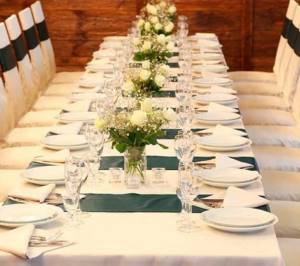
European seating arrangement
Arrangement of square or round tables for 4 to 10 people according to the area of the hall.
Pros:
you can form different groups of guests; ease of movement around the room.
Number of guests
: from 18 people.
Note:
so that everyone can see the newlyweds’ table, seat the guests not along the entire perimeter of the table, but occupying only ¾ of the space. This way, no one will sit with their back to you, the newlyweds, and it will be convenient for your family and friends to follow the progress of the celebration.
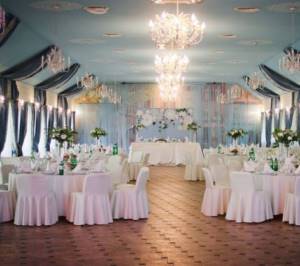
Herringbone table arrangement
An average option between the European seating system and the Russian alphabetic system. It involves several separate rectangular tables placed at an angle and symmetrically to each other. This creates a better overview and allows guests to be seated according to the principle of belonging to the bride’s side or the groom’s side. There is room in the center for dancing and free access to the newlyweds’ table. The combination of rectangular and round tables looks interesting.
Pros:
convenient arrangement of tables relative to the newlyweds’ table, the ability to form groups.
Number of guests
: from 16 to infinity. 

Note
: Provide enough space between tables so that guests can freely stand up and move around the room.
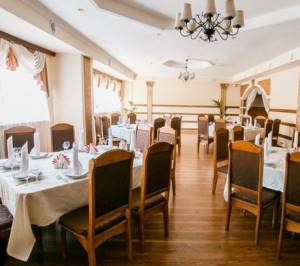
"Common table"
Long rectangular or round table.
Pros:
maintains the cozy atmosphere of a family evening. This option does not require the design of several tables, which means that one central composition per table will be enough for you.
Number of guests
for a round table: up to 20 people. For a rectangular table: up to 40 people.
Note
: This seating option is suitable for a small group of closest people. The seating arrangement should be comfortable and not cramped, so that each guest has free space at the table.
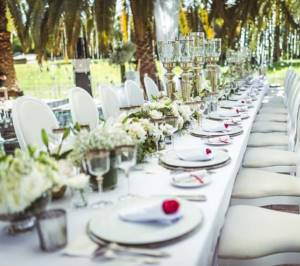
Author of the material / Elena Yushina
Photo: Pinterest
Arrangement of tables in the shape of the letter "P"
This arrangement of tables allows you to comfortably seat up to 50 guests. However, if the number of guests is not large, then it is better to place all guests on the outside of the table. Thanks to this, all guests will sit facing the newlyweds, and no one will be with their back or side.
Seating arrangement in the shape of the letter "P".
A wedding dress should be more than just an outfit, it should become an extension of you, reflect joyful emotions and emphasize the importance of the event. Choose from more than 3,000 main dresses at salon-love-forever.ru and sign up for a fitting!
Cabaret
This option is very similar to the previous one, but with one difference: the guests are placed in such a way that none of them has their back to the bride and groom. To do this, the chairs are arranged in a semicircle. Tables and chairs were placed in a cabaret in a similar way. Hence the name of this scheme.
Editor's choice: How to look thinner? Lifehacks for everyone
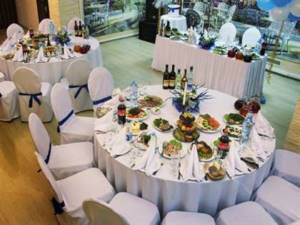
European seating chart
This seating option differs in that instead of one common table, several smaller individual tables are used. This allows you to accommodate guests in such a way as to unite them by age, interests, menu preferences, etc. This is a definite plus of this arrangement of tables.
However, taking advantage of the European seating arrangement
and by dividing your guests into smaller groups, you limit their ability to get to know each other better. Therefore, if your wedding celebration also has the goal of introducing the relatives of the bride and groom, then give the task to the host of the wedding reception so that he can think through competitions or other joint events for guests on both sides.
European table arrangements vary depending on the prevailing customs in a particular country.
General tips for seating guests at a wedding
After you have decided on the table layout for your wedding banquet that is most suitable for your event and the number of guests, you need to decide which guests will sit at which table and where. To make the holiday fun and everyone feels at ease, you should use the basic rules for seating. We offer you the most important tips that we hope will help in such an important matter.
- It is best to alternate men and women, and according to the rules of etiquette, men are usually seated to the left of women.
- Make sure that all guests can clearly see the newlyweds. Sometimes it is better to add an extra table rather than try to fit all the guests at one table.
- Close relatives of the bride and groom must be honored and seated next to the newlyweds.
- It is advisable to seat relatives according to proximity of relationship and age. Place parents with parents, elderly with elderly.
- High-ranking guests should also be seated closer to the newlyweds, showing their respect for them. But at the same time, you should not seat them at a table where only relatives will sit - they may feel uncomfortable there. It is better to seat them at a separate table or next to close friends of the bride and groom.
- Divorced friends who do not get along well should be seated at opposite ends of the room and warned in advance that they will both be present.
- If one of the guests comes without a partner, you should find him a free interlocutor, and not place him with married couples or a group of old friends.
- On the one hand, it is better not to separate close friends and work colleagues; they are used to celebrating all holidays together. On the other hand, you don’t want your friends to communicate only with each other, forgetting about other guests? Our advice is to seat a group of friends or colleagues next to each other along with another small group of friends. This will give the friends of the bride and groom a very good opportunity to get to know each other.
- According to etiquette, couples should sit opposite each other, but they are usually seated next to each other. Here it’s your choice, in the first option they will be able to communicate more with other guests, in the second case, perhaps they will be more familiar and comfortable.
- Guests who are unfamiliar to each other and who will be sitting next to each other must first be introduced to each other. If you have time before the wedding, it would be nice to have a dinner together where your guests could get to know each other in advance.
- Pay attention to the temperament of individual guests - you should not seat several merry fellows and ringleaders at one table, and calm and unsociable people at another.
- Make sure that the interests of your table neighbors at least somehow coincide and that they have fun together.
- You can organize your own separate table for the children present, this will make it more interesting for them and they will feel independent. But if there are few children at the wedding, then they can be safely seated next to their parents.
- If you have foreign guests at your wedding, make sure they sit next to English-speaking neighbors (or guests speaking their native language).
English version of table arrangement
In England, the arrangement of tables differs in that square and rectangular tables are most often used, at least the newlyweds' table is usually rectangular in shape. Besides the bride and groom, other guests (parents or witnesses) most often sit behind him.
Care must be taken that guests do not sit with their backs to the newlyweds. To do this, the table of the bride and groom is most often placed not in the center of the hall, but against one of the walls, and the tables of the guests are placed in a checkerboard pattern or along the walls.
English seating.
How to Create a Seating Plan: 8 Elementary Steps
Even at a family party with only 10-20 people, guests need to be seated in a certain order. And if you are hosting a banquet for 100 or more guests, creating a seating plan can be a real challenge. We will tell you how to compose it without unnecessary worries.
Start working on your seating plan 2-3 weeks before the celebration, when you know exactly how many guests will be at the celebration and who exactly has confirmed their intention to attend (don’t forget to count everyone “+1”).
Based on the characteristics of your room and the total number of guests, decide on the shape and number of tables. If there are a lot of guests and you plan to seat them at small tables, you don’t even need to determine a specific place for each guest, it will be enough to make a list for each table. 1. Prepare a plan on paper.
It’s most convenient to think through seating options and create different combinations if you visualize the floor plan of the room with tables. Draw a table layout and write the names of all guests on small pieces of paper. It is more convenient to take multi-colored pieces of paper, dividing guests into categories. For example, the groom’s relatives are on blue pieces of paper, the bride’s relatives are on pink ones, the groom’s friends are on green ones, etc.
2. Determine where you will sit.
Since the bride and groom are the main people at this holiday, the first thing to do is decide how you will sit. This could be a separate presidium, a small rectangular table for you and your closest relatives, or the middle of a long table.
3. Decide where you will seat your loved ones.
The next step is to plan where your closest people will sit: parents and best friends. By tradition, they should sit at the same table with you or at small tables near your presidium.
4. Ask your parents to help you.
It's time to involve your parents in preparing the wedding, especially if they included some distant relatives or their friends on the guest list. Ask which of the invitees should be seated where, who communicates well with whom, let the parents offer their seating options.
5. Unite guests based on their interests.
Seat the remaining guests so that they have something to talk about. Let connoisseurs of classical music sit at one table, book lovers at another, and lovers of active sports at a third. Your main task is to seat your guests so that everyone has fun and interest, and the atmosphere remains relaxed.
6. Avoid singles tables.
It may seem like a good idea to introduce all the bachelors and bachelorettes from your circle of friends and arrange their personal lives, but this is not entirely correct. It's difficult to predict whether your boyfriends will like each other, whether awkward moments will arise, or whether little drama will play out right at your banquet. Therefore, it is better to mix pairs and singles and follow the principle of “planting according to interests” - this way you definitely won’t go wrong.
By the way, purely “male” or “female” tables are also the wrong decision. There should be approximately equal numbers of guests of both sexes at each table.
7. Organize a children's table.
It is better to seat the little guests of the celebration at a separate low table, providing them with snacks, sweets and entertainment (for example, pencils and coloring books). In addition, you can seat an animator at the children's table to entertain the kids. It is also better to organize a separate table for teenagers - they will have something to discuss.
8. Consider the needs of guests.
When creating your seating plan, be mindful of your guests' special needs. For example, it will be more pleasant for grandparents to sit in a well-lit area away from the speakers, stage and presenter with a microphone. They'll probably want to see you and everything going on, but they won't like being in the thick of it.
Once the seating plan is ready, proceed to the next step - printing the place cards. They can become not just a useful detail, but also a real table decoration, consistent with the overall style of your decor.
Photo: Konstantin Semenikhin, Andrey Baida.
Herringbone table arrangement
An intermediate option that combines the advantages of traditional seating at a large table and European seating is a table arrangement called “Herringbone”.
With this arrangement of tables, you can comfortably accommodate a fairly large number of guests (50-60). Invitees can be grouped together at tables according to age or interests, while at each table there will be 10-12 people, enough to make new acquaintances and at the same time feel comfortable, because... There will be some familiar people.
The downside is that most guests will sit sideways or quarter-turn to the newlyweds.
How to accommodate guests if you have little space in your apartment
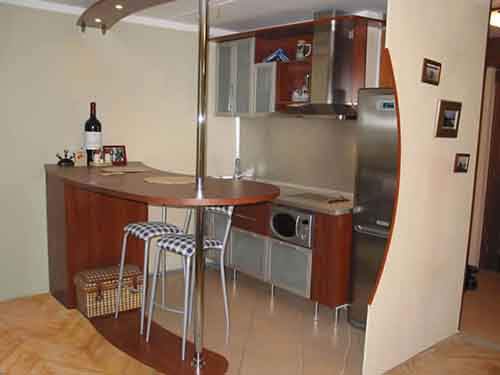
We are waiting for guests. A lot of guests. But here’s the problem: the modest dimensions of the apartment do not allow accommodating a large number of people. So what should we do? Deny yourself the pleasure of having fun? In no case!
Here's a real-life situation. We invited guests to a birthday party. We decided to gather everyone: relatives, friends and neighbors. We counted and thought. It turned out to be a lot, but there was nowhere to plant it. Maybe divide it into two groups and place one in the kitchen and the second in the hallway. It can be expensive to celebrate in a cafe. How to act without offending anyone? We tried to come up with something.
Here are just some of the ideas that arose in our heads: 1. Kebabs in the courtyard of the house. But something stopped us: the house is in the city, and the neighbors walk around, looking with sad eyes at our goodies. In general, with this situation, the holiday is unlikely to succeed;
2. Table on the floor. At first glance, the idea seems successful: a tablecloth is laid out, treats are placed on it, and satisfied guests sit around. But will they really be happy? Sitting on the floor is somehow uncomfortable, and my legs are numb. The sediment will remain, and neither dancing nor the atmosphere of general fun will help to cope with it. In general, it was decided to abandon this strange idea;
3. “Visitation schedule.” We think we will divide the guests into groups and let each one go for a couple of hours. But it will turn out somehow insincere, as if everything is for show. After all, you want to sit with the whole cheerful and friendly company on your holiday. In general, we are looking for other options;
4. Oh! Good idea! We will remove large furniture from the room and make smaller seats. So it will turn out: a small table, tiny chairs, some kind of land of Lilliputians... In general, it’s labor-intensive and inconvenient... We refuse.
5. Shouldn’t we set up a buffet table in the middle of the room? The idea seems to be not bad: everyone is standing, but everyone is assembled. Again, a treat is on the table... At least start dancing now... But it seemed to us that something was missing...
And here it is, the optimal solution that we have been waiting for so long has been found. They collected all the carpets from the apartment (so that, God forbid, they wouldn’t get stained) and took them to a neighbor’s house. The TV also went there (so as not to distract from the celebration). The slightly empty rooms were turned into separate rooms, each with its own theme.
Our living room became a disco room. There we installed a buffet table and added appropriate paraphernalia. We assigned the bedroom the role of a hookah bar, where our guests could be in silence and relax. There were also snacks: my friend Lena periodically brought a tray of food there. The room is decorated in a muted red color, the music matches the tone - a light “lounge”.
The kitchen has become a sweet corner for those who like to sit and drink. We built a bar counter in the middle of it and placed high chairs around it. Our most artistic guest, the brother of the birthday boy Petya, became a bartender. You could have fun in the kitchen not only with cocktails, but also with bets. Betting on what? Yes to anything! For example, who will enter the room first. We also had a poker set and roulette ready for the guests.
Our idea pleased both the guests and ourselves. No one was bored: everyone walked around different rooms and had a lot of fun. The birthday boy received gifts and congratulations from everyone. In general, it turned out to be fun and interesting! It’s good that the neighbors downstairs were among those invited).
Do you know where the most original birthday greetings are on the Internet? The website www.raz-v-god.com contains prose and poetry from talented authors who write unique wishes from the heart so that they can then be scattered all over the world and give joy to every birthday person. Using the free content of this congratulatory resource, you will receive regular updates with new wishes from wonderful authors. The organizers of the site also worried about a more individual approach to congratulations. On the site you will find an excellent selection of wishes for names, which take into account the specific meanings of each name. The birthday boy will not only receive attention from you, but also a sense of the significance of his qualities that symbolize his name. Even if you don’t have a person in mind today whom you want to congratulate, we suggest you bookmark the site so as not to miss the opportunity to give an original congratulation on the occasion.
American seating arrangement
In the USA, either one of the European options for arranging tables, or a specific “American” scheme is most often used. The latter is understood as a “buffet” or “buffet” type arrangement.
Buffet style seating
assumes the presence of a table for the newlyweds, two or three long guest tables and a separate table with snacks and drinks. At the same time, guests themselves approach the tables with refreshments and choose the dishes that they like. This seating arrangement allows you to save some money on paying for a banquet, because you do not have to pay for the work of the waiters. However, you should ensure that guests are comfortable with self-service and ensure that guests do not form a line around the refreshment table at the start of the event.
American table arrangement for a wedding.
Sometimes there is no time or opportunity to organize a large banquet, for example, after the official part, the newlyweds are going to immediately leave for their honeymoon. the buffet format is ideal.
How to properly receive guests
It is necessary to thoroughly prepare for the arrival of friends.
Invitation
Preparations for any holiday begin with an invitation. Depending on the celebration, guests are invited in person or by mail. Relatives and friends are invited to family celebrations verbally by phone or at a meeting.
When organizing large celebrations, it is more convenient to use invitations indicating the time and location of the event.
You should inform about the upcoming holiday in advance. People will need time to adjust their plans, choose an outfit and prepare a gift. For example, you can invite someone to a home party a week in advance, and for an anniversary - a month in advance.
Complete pair
It is not customary to invite one of the spouses. The owners call the couple. Exceptions are specific evenings - hen or stag parties.
Guests can ask permission or warn that they want to come with a boyfriend, girlfriend or child. The owners are not always aware of changes in the personal lives of friends. Knowing the number of expected visitors, it is easier to navigate the volume of food and the number of seats at the table.
Time of receipt
The choice of time for the celebration depends on the type of feast. It is customary to invite people for breakfast between 10-12 o'clock. Lunch is served from 15:00 to 19:00, and dinner is served from 19:00 to 22:00. If we are talking about tea drinking, then it is appropriate to invite friends from 17 to 19 hours.
Arrival of guests
It is unacceptable to be late for a celebration. But you shouldn’t arrive early either. If you haven't timed your visit, you can walk around the house for a while.
Guests are allowed to stay no more than 15 minutes.
If they are very late, friends must warn the hosts, who may start the feast without them.
Meeting and introduction
Guests are greeted by both spouses. The owners should be in high spirits. It’s nice to feel the festive mood and cordiality right from the door. A positive attitude helps people relax when they find themselves in unfamiliar company.
According to etiquette, guests are introduced to each other by the owners of the house, calling their names. First, men are introduced to women, and then, as new friends and colleagues arrive, they are introduced to the whole company.

Present
It is customary to give gifts on birthdays and other celebrations. The owners receive them with gratitude and a smile. Boxes are not opened in the hallway. You can view the gift in the living room.
You cannot show by appearance that you do not like the gifted item. If guests presented a gift of food or alcoholic beverages, they should be placed on the table.
Slippers
There are always problems with shoes for guests: there are not enough of them or the size of the slippers does not match. Visitors should take care of what they will wear when visiting.
For friendly gatherings, you can bring your own slippers from home. And for a special event, it is more appropriate for women to take shoes that match their outfit.
Seating at a table
An important point is to place the entire company at the table. At small home events, you can verbally suggest this or that place to guests. At large celebrations, people are given cards indicating their place.
When seating guests, you need to remember the rules:
- The hostess chooses a place to see those present. She should be able to leave the table without disturbing anyone.
- Guests of honor are seated facing the doors in the room.
- It is more appropriate to place people nearby who are interested in communicating with each other.
- In the center you can put a person whom everyone considers the soul of the party, then no one will be bored.
- Sometimes companies gather people who don't like each other. Such guests should not be placed nearby.
Serving
By the time all guests gather, the table must be set. When preparing for the celebration, you need to make sure that each person has a cloth napkin for their clothes and another one for their hands.
Dishes can be served by the hostess, the staff, or the guests themselves (if we are talking about a home feast). Each person needs to have cutlery on the table. The owners of the house begin the feast.
When preparing, carefully calculate the number of devices and chairs so that there is enough space for everyone. To play it safe, you need to anticipate the arrival of more people.
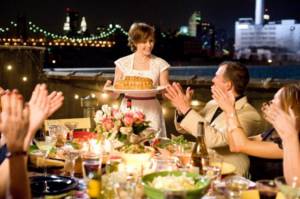
Nice atmosphere
The key to a successful holiday is a pleasant atmosphere at the table. The heroes of the occasion should propose topics for conversation that are of interest to the entire company.
If necessary, the hosts can direct the conversation, because they know all the guests and their hobbies. At the table you cannot talk about the cost of certain products, putting guests in an awkward position. The hosts set the tone for the holiday.
Moderation
Some women are too persistent in offering their friends to try certain dishes. Cultured people gather for the sake of communication. Food is a pleasant addition to conversation, but not an end in itself.
The dishes on the table should not be too fatty and filling. Otherwise, all the guests’ thoughts will be focused not on communication, but on food. The menu can include light salads, canapés, snacks, fruits, nuts, and cold cuts. Overeating kills activity and the desire to communicate.
It is necessary to avoid awkward situations at the table. It is inappropriate to find out taste preferences during a holiday. It is much more logical to ask in advance whether there are any special dietary requirements for all guests.
This does not mean that the hostess needs to adapt to her acquaintances and friends. You can simply create a menu based on the preferences of your guests. This will avoid unpleasant surprises.
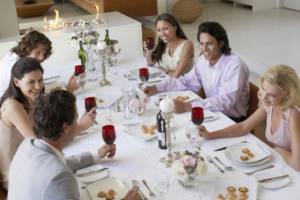
Table manners
At the table, alcoholic drinks are often spilled, and sometimes dishes or glasses are broken. The owners are uncomfortable with such situations. But they shouldn't show their feelings.
You need to act as if nothing happened. Then everyone will remain in a festive mood, and the guest will not feel awkward because of the mistake.
Forbidden topics of conversation during a feast
If there is no joker or joker in the company, maintaining the conversation falls on the shoulders of the owners. They know everyone invited. In addition, guests may feel insecure and awkward among strangers.
There are a number of topics that should not be raised at the holiday table:
- problems at work;
- health status;
- issues of religion and politics;
- parenting;
- income level.
You can start a conversation by discussing cultural news, a TV show, a book, a film or a play.
Serving dishes
Drinks are poured and food is served to older women first. The owners are the last to take the food. Cold appetizers are placed on the table before guests arrive. Hot dishes are served after people have tasted the cold cuts, canapés, and salads.
The table is placed in the middle of the room, not in the corner. A mandatory holiday attribute is a tablecloth and beautiful dishes. You should not place large bouquets in the center of the table.
Behind the flowers, guests will not see each other, which is important for communication. A good and useful table decoration is a vase with various fruits.
The feast should not be overloaded with food. It is difficult to place a large number of dishes on the table. The hostess should not force delicacies on guests. Each invitee can take care of filling their own plate.
You cannot insist on drinking alcohol. The dishes are removed from the table quietly, without attracting attention to themselves. Coffee and desserts are served in the same way, and wine glasses are filled.
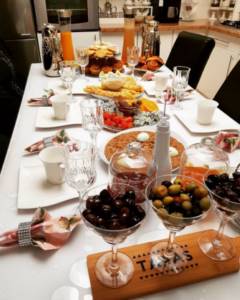
If the owner of the house needs to leave
Sometimes the owners need to leave for a while. There's nothing wrong with that. It is enough to apologize when getting up from the table. Guests can entertain their friend for a while on their own. But you shouldn't leave the company for a long time. When inviting friends, you must show hospitality.
Seeing off
Farewell to the guests is the final and important stage of the event. You can’t remind people that they’ve been sitting too long. You should not start cleaning by hinting at the end of the evening.
Serving dessert on the table indicates that the celebration is nearing its end. After sweet dishes, guests can linger for another half hour, and then they should get ready to go home.
Tactful owners persuade friends not to rush. But often this is done out of politeness. In everything you need to observe moderation. The celebration should not develop into gatherings until the morning.
Attentive hosts escort guests to the door, handing them clothes.
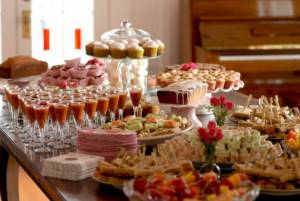





![How much money to give to newlyweds for a wedding in [year]?](https://svadba-ossetia.ru/wp-content/uploads/skolko-podarit-na-svadbu-deneg-molodozhenam-v-year-godu-330x140.jpg)





